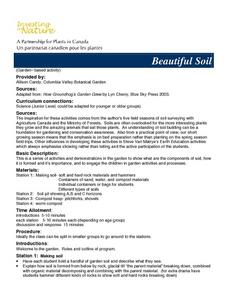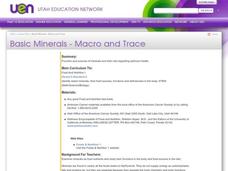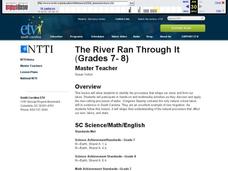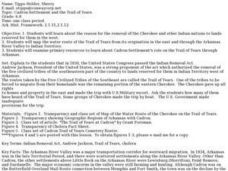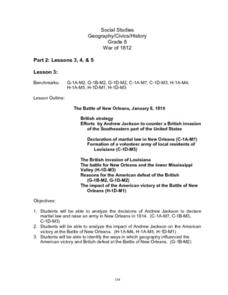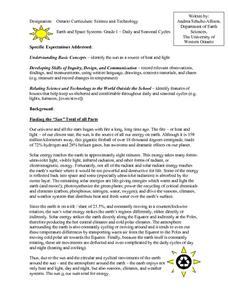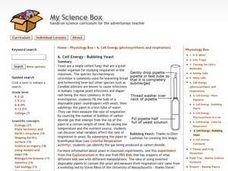Curated OER
Fiber - Adding it to the Diet - Skill Supplement
Food preparation that supports the concepts of adding fiber and water to the diet. Identify fiber, its sources and functions. National Standard 14.2.1 Identify the function of fiber Identify cellulose - non digestible fiber Discuss the...
Curated OER
Pollution Assessment: Is Wood Lake a Good Lake?
Students become aware of pollution in Richfield Minnesota's Wood Lake, identify sources of pollution in Wood Lake, learn to use variables, equations, spreadsheets and modeling software, and generate solutions for the problem.
Curated OER
Tornado!: Types and Formation
Students discuss the different types of tornadoes and how they form. Working in groups, they record journal entries by conducting experiments with water bottles simulating vortex formation.
Curated OER
Sound
Young scholars identify sources and importance of sound, discuss sounds heard on way to school, explain why sound waves can be "seen", and participate in various classroom activities and experiments that illustrate how sound travels.
Curated OER
Information And Advice On Drugs
Learners identify and analyze a variety of sources for information and statistics on drugs. They map out why its important to know the facts about drugs. In addition, they show examples of what happens when you use drugs of any kind.
Curated OER
Beautiful Soil
Students discover what are the components of soil. They examine how it is formed and it's importance. They engage in garden activities and processes. They hold a handful of garden soil and describe what they see. They take a...
Curated OER
Topography of Africa
Students study Africa's diverse landscape and investigate how these features impact the available water supply, food sources, and population distribution of the continent. They compare topographical features and
their affect on each...
Curated OER
Microbiology Lesson
Learners collect water samples and use a microscope to find bacteria in the samples. They categorize the different bacteria they find, determine the number of colonies there are, and predict how the bacteria levels might affect animals...
Curated OER
Infectious Disease Detectives
Learners participate in a simulation of how diseases are transmitted. Each student holds a test tube, with only one containing the "disease" while the others have water. They move around the room until told to stop. Using droppers to...
Curated OER
Aquifers and Groundwater
Young scholars understand the purpose of an aquifer. In this aquifer and groundwater lesson plan, students build a model aquifer find its relationship to water usage. Young scholars record observations as they build the layers of the...
Curated OER
Under Pressure: How Deep Can They Dive?
Students explore geography by conducting an in-class experiment. In this deep sea exploration instructional activity, students identify the different zones of the ocean and utilize water bottles, masking tape and scissors to conduct a...
Curated OER
Ethics Activity: Issue Analysis
Students analyze environmental health issues with respect to the players, their positions, and associated values, after being introduced to the concepts of events, problems, and issues. They apply the skills of issue analysis to...
Curated OER
Basic Minerals - Macro and Trace
Identify minerals, their sources, functions, and deficiencies in the body. National Standard 14.2.1 Discuss macro minerals, electrolytes, and trace minerals Identify the problems associated with calcium and iron
Curated OER
The River Ran Through It
Students identify the processes that shape our rivers and form our lakes. They participate in hands-on and multimedia activities as they discover and apply the river-cutting processes of water.
Curated OER
Cadron Settlement and the Trail of Tears
Young scholars examine the reason for removal of the Cherokee and other Indian nations. They map the water route of the Trail of Tears from its origination in the east and through the Arkansas River Valley to Indian Territory.
Curated OER
War of 1812
Eighth graders locate the major land forms and bodies of water on a map of Louisiana. In groups, they discuss the role of the Mississippi River in the Battle of New Orleans and how land and water affect the outcome of battles. To end...
Curated OER
History and Human Rights: A Process for Analyzing Events
Students analyze various American History topics which concern human rights. They research the topics and analyze the sources for bias or stereotype. They decide and discuss whether or not any human right were violated in each...
Curated OER
Daily and Seasonal Cycles
First graders identify the sun as a source of heat and light. They identify features of houses that help keep use sheltered and comfortable throughout daily and seasonal cycles. Students are told that summer is the best season to...
Curated OER
Cell Energy - Bubbling Yeast
Students identify that yeast are a single celled fungi that are a great model organism for studying respiration in the classroom. They also fill the bulb of a disposable pipet (eyedropper) with yeast, then submerge the pipet in a test...
Curated OER
Milk Glue
Young scholars observe a precipitation and neutralization reaction and learn to filter the products of the precipitation reaction. In this precipitation and neutralization lesson plan, students create curds and whey using milk and...
Curated OER
Exploring for Petroleum - Modeling an Oil Reserve
Students experiment with locating oil reserves. In this conservation lesson, students use a cardboard box to create sand, rocks, and an oil reserve (water balloon). They use a probe to dig around in the box to find the oil reserve and...
Curated OER
Gibbons v. Ogden (1824)
Students examine state rights and the commerce clause. For this Supreme Court lesson, students examine primary documents from Gibbons v. Ogden and discuss the implications of the decision.
Curated OER
Searching for Meteorites
Students examine meteorites and attempt to recover meteorite fragments. In this space instructional activity students complete a demonstration on the impact of a meteorite using water balloons and make experimental predictions.
Curated OER
The Artemia Hatchery
Students, in groups, develop their hatcheries, working cooperatively in its design and construction. The lessons begin with the introduction to Artemia as a primary food source of many aquaculture species during their larval stages.
Other popular searches
- Sources of Water Pollution
- Water Sources Grades K 2
- Water Sources K 2
- Activities on Water Sources
- Natural Water Sources
- Water Sources in Qatar
- Types of Water Sources
- Landforms Water Sources
- Sources of Water
- Streams as Water Sources
- Natural Sources of Water
- Water Sources in Drought







